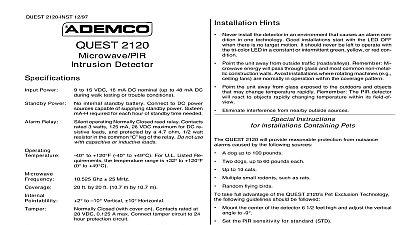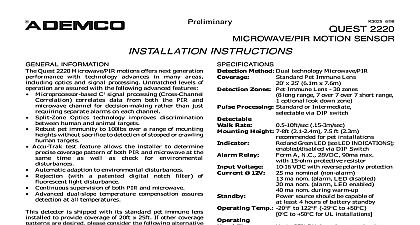Ademco - Quest 2160 Microwave-PIR Intrusion Detector

File Preview
Click below to download for free
Click below to download for free
File Data
| Name | ademco-quest-2160-microwave-pir-intrusion-detector-8629135074.pdf |
|---|---|
| Type | |
| Size | 1.06 MB |
| Downloads |
Text Preview
Installation Hints Never install the detector in a location that causes an alarm in one technol Installations should start with the LED OFF when no target motion is Never leave it to operate with the tri color LED in a constant or inter green yellow or red condition Point the unit away from outside traffic roads alleys Remember Micro energy will pass through glass and most common non metallic con walls Avoid installations where rotating machines e g ceiling fans normally in operation within the coverage pattern Point the unit away from glass exposed to the outdoors and objects that may temperature rapidly Remember The PIR detector will react to ob rapidly changing temperature within its field of view For hostile environments due to nearby traffic mount the unit seven to eight 2 to 2.5 m high and aimed downward This will form a short range trap pattern Eliminate interference from nearby outside sources The Look Down is located under the detector on the circuit board The Look zone is shown in black in the pattern drawings The Look Down lens is recommended for installations containing pets or small animals It may masked with tape like the other zones 2160 INST 12 97 2160 Intrusion Detector Power to 15 VDC 16 mA DC nominal up to 48 mA DC during testing or trouble conditions Relay internal standby battery Connect to DC power sources of supplying standby power Sixteen mA H required each hour of standby time needed operating normally closed common Form A reed Contacts rated 3 watts 0.125 amps 28 VDC maximum DC resistive loads and protected by a 4.7 ohm 1 2 watt in the common leg of the relay Do not use with or inductive loads to 120 40 to 49 For U L Listed Require the temperature range is 32 to 120 0 to Ghz 25.000 MHz ft by 60 ft 18 m by 18 m to Vertical Horizontal Closed with cover on Contacts rated at 28 VDC A max Connect tamper circuit to 24 hour protection SB2 swivel bracket use of a bracket may reduce and dead zone area Select a location likely to intercept an intruder moving across the coverage The surface should be solid and vibration free Mounting height range six to eight ft 1.8 to 2.4 m Recommended mounting height is 6 1 2 ft m Remove the cover Insert a flathead screwdriver into the locking tab hole at bottom front of the detector Pull the cover up and forward Remove the circuit board from the base Loosen the Vertical Adjustment screw slide the circuit board down then out Using the base as a template mark the location of the holes on the mounting Route wiring unpowered as necessary Route to the rear of the base and the wire entrance Firmly mount the base to the mounting surface Return the circuit board to base and tighten the Vertical Adjust Screw The protected coverage area is where the microwave and PIR overlap power only after all have been made and Do not coil excess inside the detector Terminals 1 2 Voltage limits are 9 15VDC Use no smaller than 22 AWG wire 500 feet 150m max between the detector the power source Terminals 3 4 Alarm relay reed contacts rated at 3 watts 0.125 amps maximum for DC resistive loads and protected by a 4.7 ohm 1 2 watt Do not use with capacitive or inductive loads Terminals 5 8 Spare Terminals 6 7 Tamper contacts rated at 28VDC 0.125A Plug the wire entrance hole with the foam plug that has been provided Operation detector uses a tri color LED to indicate the various alarm and supervision that may exist See chart below the detector experiences a Microwave or PIR self test failure it is in need of walk testing the LED will light for the first technology microwave or and then light red to indicate a detector alarm The LED will not indicate of the second technology by lighting its color Selection On Off pins The ON position allows of the tri color LED If the tri color indication is not desired after the setup walk tests have been completed place plug in the OFF position The OFF position does not prevent tri color LED from indicating a trouble condition Sensitivity Selection Pins Selection of the PIR response sensitivity be selected by placing the plug across the pins marked STD for standard INT for intermediate mode Sensitivity This is the recommended setting for maximum false immunity It tolerates environment extremes on this setting Sensitivity The recommended setting for any location where intruder is expected to cover only a small portion of the protected area It normal environments on this setting This setting will improve your catch performance and Walk Tests the vertical starting angle from the chart the right the vertical starting angle for the desired height and range Place the LED plug in the ON position and the cover Wait at least two minutes after applying power before starting walk tests During the warm up period the tri color LED will flash red until the unit stabilized and has seen no movement for two seconds approxi one to two minutes When the LED stops flashing the is ready to be tested With no motion in the protection area LED should be OFF If the LED is on re check the protection for disturbances affecting the microwave yellow or PIR green 2 PIR pattern coverage Turn the Microwave range adjust to minimum Walk test across the pattern at its farthest edge then several times closer to detector Start walking from outside of the intended protection area and the tri color LED The edge of the pattern is determined by the first PIR activation of the LED or the first red activation if the yellow micro LED activates first Walk test from the opposite direction to determine both boundaries The cen of the pattern should be pointed toward the center of the intended protec area Slowly bring your arm up and into the pattern to mark the lower boundary on alarm Perform this task at 10 to 20 ft 3.1 to 6.1 m from the unit Repeat above for the upper boundary The center of the pattern should not tilted upward desired coverage can not be achieved try angling the coverage pattern up down to assure the pattern is not aimed too high or low The angle of the pattern may be vertically positioned between 10 and 2 by loos the Vertical Adjust screw and sliding the circuit board up or down the board up will angle the pattern downward Tighten the screw when positioning is completed The pattern may be moved horizontally by moving the lens left right Microwave Coverage It is important to wait one minute after removing replacing the cover the microwave portion of the detector can settle and to wait at 10 seconds between the following walk testing procedures The tri color LED should be OFF before walk testing Walk test across the pattern at the intended coverage farthest end Start from outside the intended protection area and observe the tri color The edge of the microwave pattern is determined by the first yellow activation of the LED or the first red activation if the green PIR activates first adequate range can not be reached increase the Micro Range Adjust slightly Continue walk testing wait one minute after removing replacing the cover and the range until the farthest edge of desired cov has been accurately placed not adjust the microwave range higher than required Doing so will enable detector to catch movement outside of the intended coverage pattern Walk test the unit from all directions to determine all the detection pattern testing Detector Coverage With no motion in the protected area the tri color LED should be OFF before Walk test the unit from all directions to determine the detection boundaries A alarm is signaled by the first red activation of the tri color LED after initial green or yellow activation Features supervision features function as follows PIR Microwave If the PIR or microwave subsystem fails the tri color LED flash red four times per cycle The complete circuit operation of these is checked approxima


